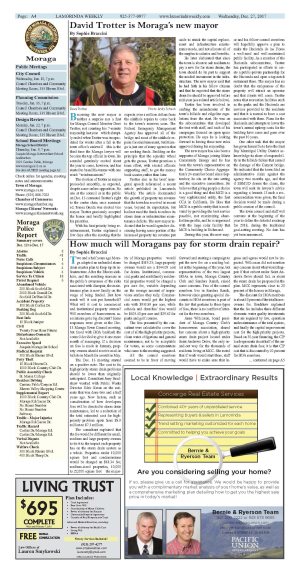| | Published December 27th, 2017
| How much will Moragans pay for storm drain repair?
| | | By Sophie Braccini | | |
Two and a half years ago Moraga adopted an unfunded storm drain master plan to keep up its infrastructure. After the Rheem sinkhole, and the resulting increase in the public's awareness of the risks associated with disrepair, the maintenance plan is now finally on the verge of being funded. But how much will it cost per household? What will it cost to commercial and institutional property owners? Will members of homeowners associations get a big discount? Some responses were given at the Dec. 13 Moraga Town Council meeting, but faced with HOA backlash the council decided to give it one more month of massaging. If a decision on fees is made in January, property owners should receive mail-in ballots in March for a result in May.
 The Dec. 13 meeting started on a positive note. The cost to fix high-priority storm drain problems should be lower than originally anticipated. Consultant Jerry Bradshaw worked with Public Works Director Edric Kwan on the estimate that was done two and a half years ago. New factors, such as consideration of how developers fees will be directed to storm drain maintenance, led to a reduction of the total estimated cost for high-priority problem spots from $8.9 million to $7.3 million.
The Dec. 13 meeting started on a positive note. The cost to fix high-priority storm drain problems should be lower than originally anticipated. Consultant Jerry Bradshaw worked with Public Works Director Edric Kwan on the estimate that was done two and a half years ago. New factors, such as consideration of how developers fees will be directed to storm drain maintenance, led to a reduction of the total estimated cost for high-priority problem spots from $8.9 million to $7.3 million.
 The consultant explained that the fee would be different for small, medium and large property owners to tie it to the impact each property has on the storm drain system as a whole. Properties under 10,000 square feet and condominiums would be charged an $81.34 fee; medium-sized properties, 10,000 to 22,000 square feet - the majority of Moraga properties - would be charged $119.23; large property owners would see a $144.09 cost for drains. Institutional, commercial, parks and multifamily residential properties would be charged a per acre fee, variable depending on the average amount of impervious surface they tally. Commercial zones would get the highest rate with $931.89 per acre, while schools and churches' fees would be $405.40 per acre and $29.62 for parks and golf courses.
The consultant explained that the fee would be different for small, medium and large property owners to tie it to the impact each property has on the storm drain system as a whole. Properties under 10,000 square feet and condominiums would be charged an $81.34 fee; medium-sized properties, 10,000 to 22,000 square feet - the majority of Moraga properties - would be charged $119.23; large property owners would see a $144.09 cost for drains. Institutional, commercial, parks and multifamily residential properties would be charged a per acre fee, variable depending on the average amount of impervious surface they tally. Commercial zones would get the highest rate with $931.89 per acre, while schools and churches' fees would be $405.40 per acre and $29.62 for parks and golf courses.
 The fees presented by the consultant were calculated to cover the cost of all the high-priority projects, clean water obligations and general maintenance, not to be acceptable for voters, as some commentators who came to the meeting suggested.
The fees presented by the consultant were calculated to cover the cost of all the high-priority projects, clean water obligations and general maintenance, not to be acceptable for voters, as some commentators who came to the meeting suggested.
 All the council members seemed to be in favor of moving forward and starting a campaign to put the new fee on a mailing ballot at the beginning of the year, but representatives of the two largest HOAs in town, Moraga Country Club and Sanders Ranch, raised some concerns. Two of the council members live in Sanders Ranch, however since granting special discounts to HOA members is part of the law that pertains to these types of fees, there is no conflict of interest for the two members.
All the council members seemed to be in favor of moving forward and starting a campaign to put the new fee on a mailing ballot at the beginning of the year, but representatives of the two largest HOAs in town, Moraga Country Club and Sanders Ranch, raised some concerns. Two of the council members live in Sanders Ranch, however since granting special discounts to HOA members is part of the law that pertains to these types of fees, there is no conflict of interest for the two members.
 Anne Willcoxon, board president of Moraga Country Club's homeowners association, shared her concern about a high-priority storm drain project located under Saint Andrews Drive, the only in-and-out way for the thousands of residents living at MCC. She noted that if work would start there, staff would have to make sure that ingress and egress would not be impacted. Willcoxon did not mention any concern about what would happen if that culvert under Saint Andrews Drive should fail, or about the storm drain fee proposed in the plan. MCC represents close to 20 percent of the homes in Moraga.
Anne Willcoxon, board president of Moraga Country Club's homeowners association, shared her concern about a high-priority storm drain project located under Saint Andrews Drive, the only in-and-out way for the thousands of residents living at MCC. She noted that if work would start there, staff would have to make sure that ingress and egress would not be impacted. Willcoxon did not mention any concern about what would happen if that culvert under Saint Andrews Drive should fail, or about the storm drain fee proposed in the plan. MCC represents close to 20 percent of the homes in Moraga.
 The discount for HOA members is about 10 percent of the total homeowners fee. Bradshaw explained that the fee includes three different elements: water quality investments that are required by law, operation and maintenance of the total system, and finally the capital improvement cost for the high-priority projects. Based on 30-year financing, the CIP load represents about half of the annual storm drain fees; it is that CIP cost that is discounted by 20 percent for HOA members.
The discount for HOA members is about 10 percent of the total homeowners fee. Bradshaw explained that the fee includes three different elements: water quality investments that are required by law, operation and maintenance of the total system, and finally the capital improvement cost for the high-priority projects. Based on 30-year financing, the CIP load represents about half of the annual storm drain fees; it is that CIP cost that is discounted by 20 percent for HOA members.
 Brent Meyers, who said he was representing the Sanders Ranch HOA board of directors, explained that this discount was not commensurate with all the work on storm drains that their HOA has made over the years. Mayor Teresa Onoda noted that Sanders Ranch homeowners had paid several thousands of dollars to insure the safety of their culverts, creeks and drains. Surely, the residents argued, all their maintenance resulted in a lesser impact on the town's global storm drain system and more discount should apply to them. Sanders Ranch includes about 250 homes, or about 5 percent of properties in Moraga.
Brent Meyers, who said he was representing the Sanders Ranch HOA board of directors, explained that this discount was not commensurate with all the work on storm drains that their HOA has made over the years. Mayor Teresa Onoda noted that Sanders Ranch homeowners had paid several thousands of dollars to insure the safety of their culverts, creeks and drains. Surely, the residents argued, all their maintenance resulted in a lesser impact on the town's global storm drain system and more discount should apply to them. Sanders Ranch includes about 250 homes, or about 5 percent of properties in Moraga.
 Council members were understanding of the two HOA's concerns and acknowledged that this entire process was being somewhat rushed, even if everyone recognizes the need for finding a solution for the storm drains under repair. The need to educate and be fair was deemed most important and the council decided that the project would be delayed by a month to allow the public works director's team to meet with differing HOA members to hear their concerns.
Council members were understanding of the two HOA's concerns and acknowledged that this entire process was being somewhat rushed, even if everyone recognizes the need for finding a solution for the storm drains under repair. The need to educate and be fair was deemed most important and the council decided that the project would be delayed by a month to allow the public works director's team to meet with differing HOA members to hear their concerns.
 The final fee proposal should get back to council by the end of January. If the proposal is approved, an intense effort of information and outreach will be conducted, including four mailings and at least two general meetings. Each property owner will receive one ballot (dual owners will have to be in agreement), which will be mailed to the town for counting. Since it's an election year, staff wants a result before June to avoid confusion.
The final fee proposal should get back to council by the end of January. If the proposal is approved, an intense effort of information and outreach will be conducted, including four mailings and at least two general meetings. Each property owner will receive one ballot (dual owners will have to be in agreement), which will be mailed to the town for counting. Since it's an election year, staff wants a result before June to avoid confusion.


|
| | | | | | | | | | | | |



